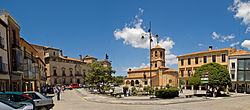Almazán
Almazán | |
|---|---|
 | |
|
UTC+2 (CEST) | |
| Postal code | 42200 |
| Website | http://www.almazan.es |
Almazán (Spanish pronunciation: Duero river.
History

In the early 10th century, fortifications were built along the Duero at
Alfonso VII of León to the bishops of Sigüenza. In 1158, Sancho III of Castile created the Almazán la Orden de Caballería de Calatrava.[5] The Church of San Miguel was built in the 12th century. In the late 13th century, civil war broke out, involving Sancho IV of Castile, who claimed the throne of Castile, and Alfonso de la Cerda, a liberal. In 1305, after various conflicts, Almazán was returned to the Castilian crown, and then in 1375, a peace agreement was signed between Pedro IV of Aragon, King of Aragon, and Henry II, king of Castile.[6]
Almazán was divided into two townships, and the town became ruled by the Mayor, assisted by six aldermen, three class gentlemen and three good men of the town. It was visited by important figures in the Catholic Church several times over the years. On March 12, 1648, the playwright Tirso de Molina died[7] in the convent of the Merced and presumably lies in the convent cemetery.
During the Spanish War of Independence, on July 10, 1810, the town was taken by French General
Covarrubias and Lodares del Monte.[6]
Notable people
Lexicographer María Moliner grew up in the town,[8] after moving from her birthplace, the Aragonese town of Paniza.
References
- ^ Municipal Register of Spain 2018. National Statistics Institute.
- ^ "Diocese of Osma-Soria". Catholic-Hierarchy.org. David M. Cheney. Retrieved 21 January 2015.
- ISBN 978-1-136-77161-3.
- ^ González, Julio (1975). Repoblación de Castilla la Nueva (in Spanish). Universidad Complutense, Facultad de Filosofía y Letras. p. 129.
- ^ a b c "Historia" (in Spanish). Almazanvilla.e. Archived from the original on 8 June 2013. Retrieved 18 September 2014.
- ISBN 978-0-313-28732-9.
- ISBN 978-84-7506-930-2.
External links
- Church of San Miguel photos (in Spanish)

